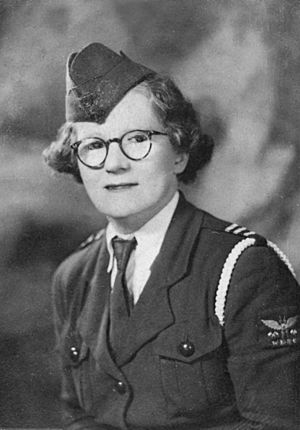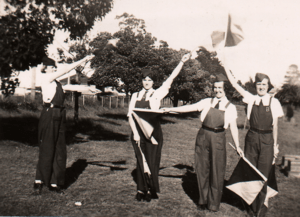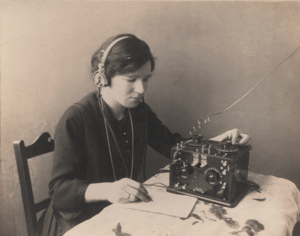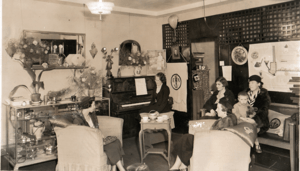Florence Violet McKenzie facts for kids
Quick facts for kids
Florence Violet McKenzie
|
|
|---|---|

McKenzie in uniform c. 1940
|
|
| Born |
Florence Violet Granville
28 September 1890 Melbourne, Australia
|
| Died | 23 May 1982 Sydney, Australia
|
| Other names |
|
| Alma mater | Sydney Technical College |
| Occupation | Electrical engineer |
| Known for | Founding the Women's Emergency Signalling Corps |
Florence Violet McKenzie (born Granville; 28 September 1890 – 23 May 1982) was an amazing Australian woman. Many people knew her as "Mrs Mac". She was Australia's very first female electrical engineer. This means she was an expert in how electricity works and how to use it.
Mrs Mac also started the Women's Emergency Signalling Corps (WESC). She worked hard to help women get technical education. She even convinced the Navy to let women join, which led to the creation of the Women's Royal Australian Naval Service (WRANS). About 12,000 service members learned important skills like Morse code from her school in Sydney.
In 1918, she opened her own electrical business. She even became her own apprentice to meet the requirements for her engineering diploma. People called her Australia's "Mademoiselle Edison". In 1922, she became the first Australian woman to get a licence to operate an amateur radio. Her "Wireless Shop" in Sydney was a famous place for radio fans. She also started The Wireless Weekly magazine in 1922. In 1934, she created the Electrical Association for Women. She even wrote the first "all-electric cookbook" in 1936. Later in life, she exchanged letters with the famous scientist Albert Einstein.
Contents
Early Life and Education
Florence Violet Granville was born in Melbourne, Australia, on 28 September 1890. When she was two years old, her family moved to Austinmer, near Sydney. She went to Thirroul Public School.
From a young age, Violet loved electricity and inventing things. She remembered playing with bells and buzzers around her house. She would even set up a light in a dark cupboard for her mother. This showed her early interest in how things worked.
Violet later earned a scholarship to study at Sydney Girls' High School. After finishing high school in 1909, she planned to become a mathematics teacher. But her older brother became an electrical engineer in England. This inspired her. In 1915, she decided to study electrical engineering at Sydney Technical College. She earned her diploma in March 1922. This was the first electrical engineering diploma given to a woman in Australia. She later gave her diploma to the Powerhouse Museum so others could see it.
Starting Her Own Business
To study engineering, Violet needed to be working in the field. So, she decided to start her own electrical business. She printed business cards and found a job installing electric lights in a house. This allowed her to enroll at the Technical College.
Violet married Cecil Roland McKenzie on New Year's Eve 1924. Cecil was also an electrical engineer and a radio enthusiast. They built a house in Greenwich Point with a special room for wireless radio in the attic.
Early Career and Radio Interests
Before becoming an engineer, Violet taught mathematics. But she soon focused on electrical work. She installed electricity in homes and factories.
She loved experimenting with wireless radio. In 1922, she got her first licence to receive radio signals. In 1925, she became the first woman to pass the Amateur Operator's Proficiency Certificate. This allowed her to send radio signals too. Her call sign was VK2FV.
The Wireless Shop
In 1922, Miss Wallace (her name before marriage) opened "The Wireless Shop" in the Royal Arcade in Sydney. It was known as the oldest radio shop in town. Schoolboys visiting her shop taught her Morse code.
At her shop, she and three friends started Australia's first weekly radio magazine, "The Wireless Weekly". This magazine later became "Radio & Hobbies" and then "Electronics Australia". It was published until 2001.
In 1924, McKenzie became the only female member of the Wireless Institute of Australia. That same year, she visited the United States. In San Francisco, she even spoke on a radio station, talking about the differences between tram systems. She also experimented with improving television using chemistry.
Other Interests
The McKenzies also loved tropical fish. They had a huge fishpond at their home. Violet even gave talks on the radio about tropical fish. She wrote an article for an American journal about interesting sea creatures from Sydney.
In the 1930s, McKenzie joined the British-based Women's Engineering Society. This was the only group for women engineers in the world at that time.
Teaching Women About Electricity
In the 1930s, McKenzie started teaching other women about electricity and radio. She saw that many women wanted to learn. In 1925, she thought about starting a "Women's Wireless Club". In 1931, she wanted to see radio and electricity courses in girls' schools.
The next year, she opened a Women's Radio College in Sydney. She even helped her students find jobs. One student remembered that Mrs Mac convinced a company to hire her and other girls. They became the first women to work in the radio section of that company.
McKenzie believed electricity could make women's lives easier at home. In 1934, she founded the Electrical Association for Women (EAW). She taught women how to use electrical appliances safely. She also gave talks on how to help someone who had received an electric shock.
By 1936, she had sold her Wireless Shop. She focused on the EAW. She gave cooking demonstrations using electric appliances. She also wrote the EAW Cookery Book, Australia's first "all-electric" cookbook. It was very popular and was printed many times. In 1938, she wrote a children's book about electrical safety called The Electric Imps.
In July 1938, McKenzie became the treasurer and Morse code instructor for the Australian Women's Flying Club.
Women's Emergency Signalling Corps
In 1939, as World War II was starting, McKenzie created the Women's Emergency Signalling Corps (WESC). People called it "Sigs". Her idea was to train women in telegraphy (sending messages) so they could take over civilian communication jobs. This would free up skilled men to fight in the war. By the time the war began, 120 women were trained to be instructors.

McKenzie worked hard to get her trained women accepted into the Air Force and Navy. At first, there was a lot of resistance. In 1940, she offered her Signalling Corps to the Minister of the Navy, WM (Billy) Hughes. She suggested they could be telegraphists or even instructors.
In early 1941, a Navy officer visited WESC and saw how skilled McKenzie's trainees were. He recommended the Navy accept them. After McKenzie threatened to offer her women to the Air Force instead, the Navy finally agreed. On 21 April 1941, the Navy allowed women to join. This was the beginning of the Women's Royal Australian Naval Service – the WRANS! The minister wanted to keep it quiet because it was a big change.
On 28 April 1941, McKenzie went with 14 of her WESC trainees to Harman in Canberra. The women wore their green WESC uniforms, which McKenzie had designed. It took several months for the Navy to create a uniform for women. Francis Proven became WRANS number 1. By the end of the war, about 2,600 women had joined the WRANS. McKenzie trained about 3,000 women in total. One-third of them joined the military services.
In May 1941, the Air Force made McKenzie an honorary flight officer. This allowed her to train Air Force personnel. This was the only official recognition she received during the war for her amazing work.
Post-War Wireless Training
After the war, Violet McKenzie continued to help people. She kept her school open to teach wireless signalling. She trained men from the merchant navy, pilots, and others who needed a "signaller's ticket" for their jobs.
In 1948, a reporter visited her school. He described how many different types of students were there. There were Chinese, Burmese, and American students. There were pilots, ship officers, and even an ex-RAF Wing-Commander. McKenzie said that after the war, many airmen wanted to join Qantas (an airline), but they needed to improve their Morse code speed.
The Department of Civil Aviation even set up a room at her school with special equipment for pilots to train. From 1948, McKenzie held a First Class Flight Radio Telephony Operator Licence herself.
Many pilots who later worked for airlines in Australia owed a lot to Mrs Mac. She didn't charge for her training. One ex-airman said she was "quite out of pocket" because she gave her training for free. There was no other school in Sydney offering free Morse training for pilots.
Famous aviators like Patrick Gordon Taylor and Cecil Arthur Butler trained at McKenzie's school. She also trained Mervyn Wood, who later became the Commissioner of Police in New South Wales.
McKenzie closed her school in 1954. She said she closed it when airlines started their own schools and the government added a signals training section to the Technical College. She still helped students with special needs at her home.
Later Life and Awards
Correspondence with Einstein
In early 1949, McKenzie started writing letters to the famous scientist Albert Einstein. She wished him well after an illness. She sent him gifts like shells and a boomerang. She even sent him a recording of didgeridoo music when he couldn't figure out how to play the instrument she sent him.
Awards and Honours
On 8 June 1950, McKenzie was awarded the Officer of the Order of the British Empire (OBE). This was for her important work with the WESC. In 1957, she became a Fellow of the Australian Institute of Navigation. In 1964, she became the Patron of the Ex-WRANS Association. In 1979, she was made a Member of the Royal Naval Amateur Radio Society. In 1980, a special plaque was put up to celebrate her skills and kindness.
Final Years
Violet McKenzie lived longer than her husband Cecil, who passed away in 1958. In May 1977, after a stroke, she moved to a nursing home. She passed away peacefully on 23 May 1982. At her funeral, 24 serving WRANS formed a Guard of Honour. The newsletter of the Ex-WRANS Association dedicated an issue to her. Two days before she died, McKenzie said, "...it is finished, and I have proved to them all that women can be as good as, or better than men."
Images for kids
See also
 In Spanish: Florence Violet McKenzie para niños
In Spanish: Florence Violet McKenzie para niños






